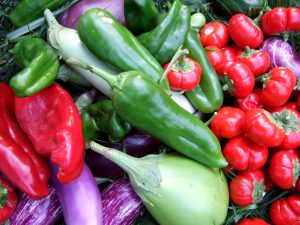The recent cool snap has put us back on track temperature-wise. If you’ve already planted warm weather veggies, they’ve probably slowed down their initial growth. A few days of 80 degree sun will get them going again, but if you haven’t started your spring vegetable patch, now is the time!
Many warm weather crops can be direct seeded in a sunny spot now that the danger of frost is past. Beans, both pole and bush, are easy and prolific. Popular veggies include cucumber, melons, squash, corn, and sweet potatoes. Warm weather favorites like tomatoes, peppers, eggplant, and tomatillos should have been started in January and protected from the cold. They’re ready for the garden. (Plant tomatillos in multiples – they like to cross-pollinate.) Some vegetables are pretty enough to mix into your landscaping. Okra has beautiful hibiscus-like blossoms in the morning, and Malabar spinach is a decorative vine that will provide you with fresh greens all summer long. For more veggie choices and when to plant them, see http://edis.ifas.ufl.edu/vh021.
Critters like snacking on edamame and pumpkin seeds as much as humans, so when planting seeds directly in the ground, consider covering the planting site with hardware cloth until the seedlings emerge. Another strategy is upending a wire basket from the dollar store over a tender baby plant and securing it with a landscape pin to keep away hungry deer. Keep the site watered until the plant has time to send roots deep enough to find moisture when the surface of the soil dries out.
If you didn’t start seeds, there are lots of choices at the garden centers. Look for transplants that haven’t outgrown their pots. A younger healthy plant will soon outgrow a leggy root bound one. Make sure the leaves aren’t turning yellow or wilting and examine the undersides for pests. Check to see if there are multiple plants in the pot – you may think you’re getting two pepper plants for the price of one, but unless you can separate them without damaging the roots, two crowded together won’t produce as much as a single healthy plant. Many gardeners remove any flowers or fruits when setting the transplant in the ground to ensure it has energy for growing strong roots.
While you’re at the garden center, don’t forget to look for herbs – mint grows easily (keep it contained!) and adds flavor to iced tea and vinaigrettes. Many Mediterranean herbs such as rosemary, oregano, and basil love the heat as long as they have good drainage. Try them in a pot or a raised bed. Once you start cooking with fresh herbs, you’ll never go back to dried.
A little effort now should result in home-grown produce in a few months. Start looking for recipes so you’ll be ready when the harvest comes. Bon Appetit!
***This blog post was written by UF IFAS Extension Orange County Master Gardener, Mary Ann Pigora, class of 2017. The UF IFAS Extension Orange County Master Gardener Volunteers play a crucial role in the outreach of UF IFAS Extension.
 0
0

